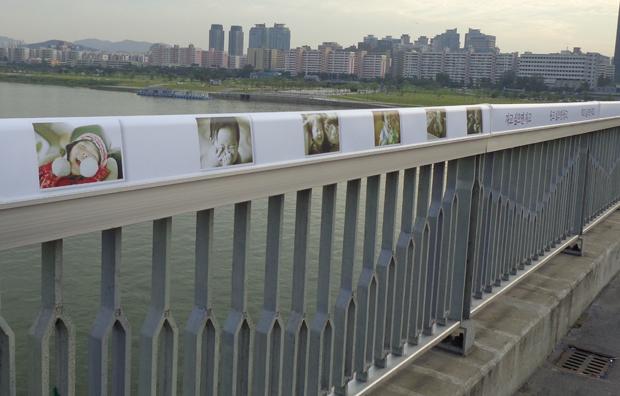South Korea takes steps to reduce suicides on Seoul bridge
People walking along the Mapo Bridge in Seoul see pictures of babies as well as inspirational slogans. Officials hope the photos will strike a chord people considering suicide. (Photo by Jason Strother.)
South Korea has the highest suicide rate among countries in the Organization for Economic Cooperation and Development.
That may have something to do with the intense pressure on Koreans to succeed at school and on the job. Government officials are trying to do something to address the issue, though. In Seoul, they’re making modifications to a bridge that’s become a popular spot for suicide attempts.
Over the guardrails of the Mapo Bridge, it’s a 60-foot drop into the Han River. That’s usually not high enough for people to die on impact, but many people have tried.
In the past five years, at least 100 South Koreans have jumped into the river. About half of them died. Of the 31 bridges across the Han, Mapo seems to be the top choice for jumpers.
Tired of it being referred to as the bridge of death, Seoul city officials recently made some changes to the bridge. Now officials are calling it the bridge of life.
Instead of installing high fences to deter jumpers, officials chose a strategy of appealing to emotions.
Park Young-ki of the Korea Suicide Prevention Group was contracted by the city to give Mapo Bridge a new look.
“Most people commit suicide because they have trouble communicating and feel isolated,” Park said. “So this bridge will make people feel they are wanted and help them open up too.”
All along the guardrails are inspirational slogans that light up as you pass by. They say things like, “How are you doing?” “Isn’t it nice to be walking on a bridge?” and “Did you eat anything yet?”
There are also pictures of babies on the rail, and at the center of the bridge is a bench with a brass statue of a stooped young man, being comforted with a pinch on the left cheek by a grandfatherly looking gentlemen.
If anything, it’s a unique approach to suicide prevention from a country with one of the highest suicide rates in the world.
But not everyone is impressed by the bridge of life and its positive messages.
“I was just walking here, talking to you, and I didn’t even notice it here,” said Dr. Kim Hyun-chung, a psychiatrist at the National Medical Center in Seoul, who came along to check out the new installations.
She says she thinks some of the new features could actually be counter productive, as she looks at pictures of a baby.
“It might make someone more sad, because maybe they lost a child. It could be someone they miss very much and want to go with them,” she said.
Kim says the officials missed an opportunity. The new signs and images don’t provide any help if a person with suicidal thoughts decides to walk back off the bridge.
“Maybe they’re trying to move your emotions a bit, but maybe they should give out more facts, like there are people willing to listen to you, there are better ways to solve your problems, please contact such and such a number. Maybe that would have been more helpful,” she said.
Suicide is still a taboo subject in South Korea, Kim says, and there’s no public dialogue about it, which leaves many people feeling it’s an acceptable way out of their problems.
Park acknowledges the new features don’t tackle all of the issues, but says it’s a start.
“There is a need for suicide education and our organization is working to put similar messages not just on bridges, but also in schools,” he said.
For her part, Kim concedes it’s a good step that the government is at least trying to address Korea’s suicide problem. But she says depressed people need more help than just positive messages on light-up guardrails.
“It just makes them more lonely,” she said. “We need to have more interest in people around us and listen to their difficulties. Nowadays people are so busy and caught up with their own problems; they really don’t have time to listen to one another.”
Kim says suicide attempts at the Mapo Bridge may go down now, but if someone is really determined to jump to their death, there are plenty of other bridges across the Han River.
